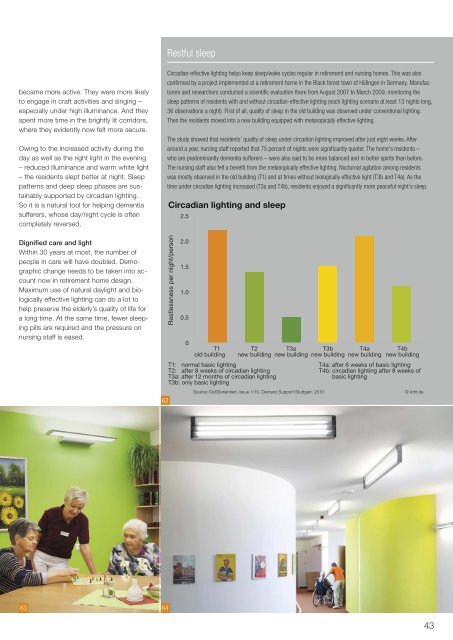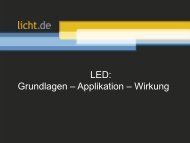licht.wissen 19 No. "Impact of Light on Human Beings"
Light synchronises our “internal clock”. Lighting that copies daylight has more than just a visual impact; it supports bodily functions 24 hours a day. Booklet 19 is intended for all those who want to delve into the topic of Impact of Light on Human Beings. The 56 pages helps to get an overview of what melanopic light can effect. Free Download at www.licht.de/en
Light synchronises our “internal clock”. Lighting that copies daylight has more than just a visual impact; it supports bodily functions 24 hours a day. Booklet 19 is intended for all those who want to delve into the topic of Impact of Light on Human Beings. The 56 pages helps to get an overview of what melanopic light can effect. Free Download at www.licht.de/en
You also want an ePaper? Increase the reach of your titles
YUMPU automatically turns print PDFs into web optimized ePapers that Google loves.
Restful sleep<br />
became more active. They were more likely<br />
to engage in craft activities and singing –<br />
especially under high illuminance. And they<br />
spent more time in the brightly lit corridors,<br />
where they evidently now felt more secure.<br />
Owing to the increased activity during the<br />
day as well as the right light in the evening<br />
– reduced illuminance and warm white light<br />
– the residents slept better at night. Sleep<br />
patterns and deep sleep phases are sustainably<br />
supported by circadian lighting.<br />
So it is a natural tool for helping dementia<br />
sufferers, whose day/night cycle is <str<strong>on</strong>g>of</str<strong>on</strong>g>ten<br />
completely reversed.<br />
Dignified care and light<br />
Within 30 years at most, the number <str<strong>on</strong>g>of</str<strong>on</strong>g><br />
people in care will have doubled. Demographic<br />
change needs to be taken into account<br />
now in retirement home design.<br />
Maximum use <str<strong>on</strong>g>of</str<strong>on</strong>g> natural daylight and biologically<br />
effective lighting can do a lot to<br />
help preserve the elderly’s quality <str<strong>on</strong>g>of</str<strong>on</strong>g> life for<br />
a l<strong>on</strong>g time. At the same time, fewer sleeping<br />
pills are required and the pressure <strong>on</strong><br />
nursing staff is eased.<br />
Circadian-effective lighting helps keep sleep/wake cycles regular in retirement and nursing homes. This was also<br />
c<strong>on</strong>firmed by a project implemented at a retirement home in the Black forest town <str<strong>on</strong>g>of</str<strong>on</strong>g> Hüfingen in Germany. Manufacturers<br />
and researchers c<strong>on</strong>ducted a scientific evaluati<strong>on</strong> there from August 2007 to March 2009, m<strong>on</strong>itoring the<br />
sleep patterns <str<strong>on</strong>g>of</str<strong>on</strong>g> residents with and without circadian-effective lighting (each lighting scenario at least 13 nights l<strong>on</strong>g,<br />
36 observati<strong>on</strong>s a night). First <str<strong>on</strong>g>of</str<strong>on</strong>g> all, quality <str<strong>on</strong>g>of</str<strong>on</strong>g> sleep in the old building was observed under c<strong>on</strong>venti<strong>on</strong>al lighting.<br />
Then the residents moved into a new building equipped with melanopically effective lighting.<br />
The study showed that residents’ quality <str<strong>on</strong>g>of</str<strong>on</strong>g> sleep under circadian lighting improved after just eight weeks. After<br />
around a year, nursing staff reported that 75 percent <str<strong>on</strong>g>of</str<strong>on</strong>g> nights were significantly quieter. The home’s residents –<br />
who are predominantly dementia sufferers – were also said to be more balanced and in better spirits than before.<br />
The nursing staff also felt a benefit from the melanopically effective lighting. <str<strong>on</strong>g>No</str<strong>on</strong>g>cturnal agitati<strong>on</strong> am<strong>on</strong>g residents<br />
was mostly observed in the old building (T1) and at times without biologically effective light (T3b and T4a). As the<br />
time under circadian lighting increased (T3a and T4b), residents enjoyed a significantly more peaceful night’s sleep.<br />
Circadian lighting and sleep<br />
Restlessness per night/pers<strong>on</strong><br />
2.5<br />
2.0<br />
1.5<br />
1.0<br />
0.5<br />
0<br />
T1 T2 T3a T3b T4a T4b<br />
old building new building new building new building new building new building<br />
T1: normal basic lighting<br />
T2: after 8 weeks <str<strong>on</strong>g>of</str<strong>on</strong>g> circadian lighting<br />
T3a: after 12 m<strong>on</strong>ths <str<strong>on</strong>g>of</str<strong>on</strong>g> circadian lighting<br />
T3b: <strong>on</strong>ly basic lighting<br />
T4a: after 6 weeks <str<strong>on</strong>g>of</str<strong>on</strong>g> basic lighting<br />
T4b: circadian lighting after 8 weeks <str<strong>on</strong>g>of</str<strong>on</strong>g><br />
basic lighting<br />
62<br />
Source: DeSSorientiert, issue 1/10, Demenz Support Stuttgart, 2010<br />
© <str<strong>on</strong>g>licht</str<strong>on</strong>g>.de<br />
63<br />
64<br />
43

















